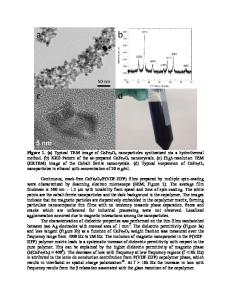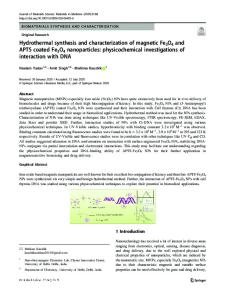Magnetic Characterization of CoFe 2 O 4 Nanoparticles
- PDF / 321,128 Bytes
- 6 Pages / 612 x 792 pts (letter) Page_size
- 6 Downloads / 392 Views
N9.8.1
Magnetic Characterization of CoFe2O4 Nanoparticles G. Lawes1, B. Naughton2, D.R. Clark2, A.P. Ramirez3, R. Seshadri2 1 Los Alamos National Laboratory, Los Alamos, NM 87544 2 Materials Department, UC Santa Barbara, Santa Barbara, CA 93106 3 Bell Laboratories, Lucent Technologies, 600 Mountain Ave, Murray Hill, NJ We have synthesized CoFe2O4 nanoparticles with length scales ranging from 3.5 nm to 14.2 nm. We have characterized the magnetic properties of these samples using both DC and AC magnetization, and find some slightly anomalous behavior in two of the samples. We tentatively attribute these features to interactions between the magnetic nanoparticles. There is a great deal of interest in understanding the physical basis for the magnetic properties of nanoparticles in order to facilitate their incorporation into a wide range of commercial applications. By studying the magnetic characteristics of CoFe2O4 nanoparticles using bulk measurement techniques, we are able to probe the properties of both the individual nanoparticles and interactions in these systems. In this report, we discuss our magnetic characterization of a series of CoFe2O4 nanoparticles grown using an aqueous co-precipitation technique. In addition to DC magnetization at fixed fields and temperatures, we also investigated the magnetic properties using AC susceptibility measurements. The long term goal of this research is to understand interparticle interactions in magnetic nanoparticles. Bulk CoFe2O4 forms an inverse spinel structure, with the Co2+ located principally on the octahedral sites, while Fe3+ occupy both the octahedral and tetrahedral sites. The competition between these magnetic ions produces ferrimagnetic ordering below 798K[1] with a low temperature saturation magnetization of 93 emu/g. The magnetic properties of CoFe2O4 nanoparticles are sensitive to finite size effects. Particles smaller than 40 nm are single domain with significant magnetic anisotropy[2] which leads to superparamagnetic behaviour. Furthermore, the spins on the surface of the nanoparticles are subject to a different magnetic environment than the bulk spins[3]. The CoFe2O4 nanoparticles were synthesized using an aqueous co-precipitation technique[4]. The samples were prepared by combining cobalt and iron nitrates in water with the addition of NaOH in the presence of polyethelyne glycol (PEG-6000) as a capping agent. After centrifuging the particles, they were washed with water and dried in a vacuum oven at 60C. This synthesis technique has the advantage that relatively large quantities (>2g) can be prepared in a single batch. The CoFe2O4 nanoparticles were characterized via X-ray diffraction (XRD) using a commercial diffractometer (Philips X’PERT MPD). A representative spectrum is displayed in Figure 1; the nominal size of the nanoparticles is 14.2 nm. The XRD pattern shows several Bragg peaks which are indexed by a cubic spinel lattice. The sample is composed primarily of single crystal nanoparticles where the widths of the peaks are determined mainly by the fi
Data Loading...










